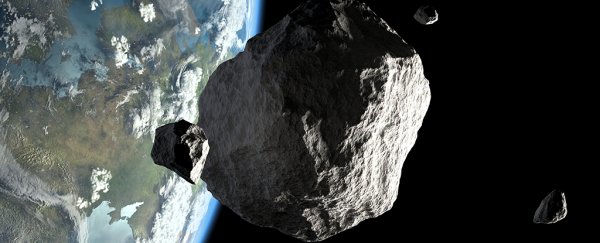Our Solar System suddenly feels a little more cluttered, with NASA's Near-Earth Object mission having just released a year's worth of survey data, putting a bunch of new space rocks on our radar.
Most of the asteroids, comets, and general clumps of cosmic dandruff are too far away to be considered a threat to our planet, but NASA will be sure to keep a close eye on 10 objects that thinks could be big and near enough to be considered a hazard.
As the name suggests, NASA's Near-Earth Orbit Wide-field Infrared Survey Explorer (NEOWISE) is an orbiting telescope that looks for objects in our Solar System with orbits that could bring them close to our planet.
In 2010, NASA's Wide-field Infrared Survey Explorer spacecraft ran low on coolant for its telescope, so researchers scaled down the mission to scan the skies closer to home rather than looking all over the cosmos.
After entering a brief two-year nap in 2011, the spacecraft was reactivated, and has since characterised a total of 693 near-Earth objects. Of those, 114 had never been seen before.
This past year alone, NEOWISE has discovered 5 new comets, 64 main belt asteroids, and 28 near-Earth objects.
It found these by using its low infra-red bandwidth telescope to snap 2.6 million images of the sky.
A new technique called tail-fitting has now allowed researchers to use the database of images to model comet behaviour as they sweep through the Solar System.
"Comets that have abrupt outbursts are not commonly found, but this may be due more to the sudden nature of the activity rather than their inherent rarity," says Emily Kramer from NASA's Jet Propulsion Laboratory (JPL) in California.
"It is great for astronomers to view and collect cometary data when they find an outburst, but since the activity is so short-lived, we may simply miss them most of the time."
To get some idea of the total number of objects out there, take a look at the video clip below, which shows the orbits of asteroids in grey, near-Earth objects in green, and comets in yellow:

But what about those 10 potentially hazardous asteroids (PHA)? Is it time to invest in silver and wait out the fireball in grandpa's bunker?
PHAs are classified as asteroids that have a minimum orbit intersection distance of 0.05 astronomical units (1 AU is the distance from Earth to the Sun, so 0.05 AU is about 7.5 million kilometres, or 4.6 million miles).
They also must be big enough to have an absolute magnitude of 22 or brighter, which would make them bigger than 140 metres (around 500 feet) in size, assuming they were reflective enough.
So far, we know of 1,806 of these objects, and while some will give us a close shave in coming years, none seem to be destined for our backyard.
Don't upset grandpa any time soon, though - a team of astronomers from the Czech Academy of Sciences think the risk of being hit with a big rock in coming years is growing.
Their conclusions are based on an analysis of 144 meteors from the Taurid meteor showers that have hit our atmosphere and exploded, also commonly called bolides.
Along with the comet Encke, the Taurids are thought to be the remains of an even bigger comet that has been disintegrating over the past 20,000 to 30,000 years.
The researchers claim they have detected a new branch of debris, one that they suspect holds at least two asteroids between 200 and 300 metres (about 650 and 1,000 feet) in size.
"Most probably, the branch also includes many undetected asteroids which are dozens of metres in diameter or larger," the Czech academy said in a press release.
"Hence, the danger of a crash with an asteroid grows markedly once every few years that the Earth encounters this stream of inter-planetary material."
The researchers noted that the asteroids they observed that were larger than 300 grams (about 10.5 ounces) were extremely fragile.
Not that a fragile 300-metre-wide rock ploughing through out atmosphere isn't at least some cause for concern.
As usual, the message is we need to keep our eyes peeled and keep track of the things orbiting the Sun with us. Because it's not like we have any big plans in case one takes us by surprise.
Thanks, NEOWISE! Let's hope this next year is another productive one.
The Taurids meteor research was published in Astronomy and Astrophysics.
